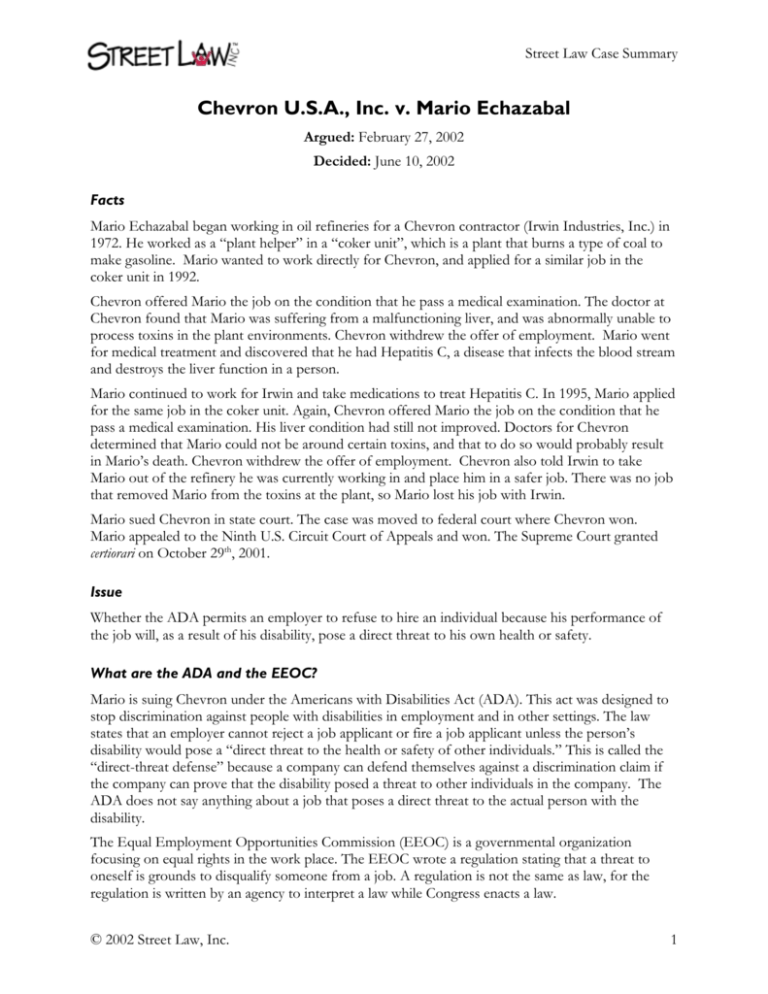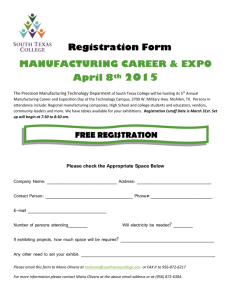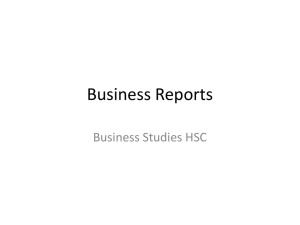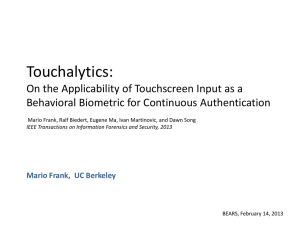Chevron v. Echazabal (2002)
advertisement

Street Law Case Summary Chevron U.S.A., Inc. v. Mario Echazabal Argued: February 27, 2002 Decided: June 10, 2002 Facts Mario Echazabal began working in oil refineries for a Chevron contractor (Irwin Industries, Inc.) in 1972. He worked as a “plant helper” in a “coker unit”, which is a plant that burns a type of coal to make gasoline. Mario wanted to work directly for Chevron, and applied for a similar job in the coker unit in 1992. Chevron offered Mario the job on the condition that he pass a medical examination. The doctor at Chevron found that Mario was suffering from a malfunctioning liver, and was abnormally unable to process toxins in the plant environments. Chevron withdrew the offer of employment. Mario went for medical treatment and discovered that he had Hepatitis C, a disease that infects the blood stream and destroys the liver function in a person. Mario continued to work for Irwin and take medications to treat Hepatitis C. In 1995, Mario applied for the same job in the coker unit. Again, Chevron offered Mario the job on the condition that he pass a medical examination. His liver condition had still not improved. Doctors for Chevron determined that Mario could not be around certain toxins, and that to do so would probably result in Mario’s death. Chevron withdrew the offer of employment. Chevron also told Irwin to take Mario out of the refinery he was currently working in and place him in a safer job. There was no job that removed Mario from the toxins at the plant, so Mario lost his job with Irwin. Mario sued Chevron in state court. The case was moved to federal court where Chevron won. Mario appealed to the Ninth U.S. Circuit Court of Appeals and won. The Supreme Court granted certiorari on October 29th, 2001. Issue Whether the ADA permits an employer to refuse to hire an individual because his performance of the job will, as a result of his disability, pose a direct threat to his own health or safety. What are the ADA and the EEOC? Mario is suing Chevron under the Americans with Disabilities Act (ADA). This act was designed to stop discrimination against people with disabilities in employment and in other settings. The law states that an employer cannot reject a job applicant or fire a job applicant unless the person’s disability would pose a “direct threat to the health or safety of other individuals.” This is called the “direct-threat defense” because a company can defend themselves against a discrimination claim if the company can prove that the disability posed a threat to other individuals in the company. The ADA does not say anything about a job that poses a direct threat to the actual person with the disability. The Equal Employment Opportunities Commission (EEOC) is a governmental organization focusing on equal rights in the work place. The EEOC wrote a regulation stating that a threat to oneself is grounds to disqualify someone from a job. A regulation is not the same as law, for the regulation is written by an agency to interpret a law while Congress enacts a law. © 2002 Street Law, Inc. 1 Chevron U.S.A., Inc. v. Mario Echazabal Arguments for Chevron, U.S.A The EEOC, in interpreting the ADA, explicitly states that when a job applicant is at substantial risk to harm himself, and that risk can’t be helped by making reasonable accommodations, it is permissible to reject the applicant on the grounds that the applicant is not qualified. Individuals who will become sick or die from a work environment are not reliable and cannot work on an ongoing basis. Allowing employees to die on the job lowers other employee morale and interferes with productivity in the plant. This will also increase company costs for insurance and worker’s compensation claims, and generate bad publicity for the company Allowing Mario to prevail will conflict with state laws that make it a crime to permit an employee to work in an unsafe workplace. The decisions Chevron made about Mario’s health problems were reasonable and wellsupported by the available medical evidence and advice. Arguments for Mario Echazabel Congress did not put in a threat-to-self justification for excluding individuals with disabilities. The “direct threat defense” only applies to threats against other individuals. To allow the “direct threat-to-self defense” would be too paternalistic. This means the government would be like an overprotective parent and restricting what people can choose to do based on what the government believes is best for those people. This would lead to a denial of opportunities for people with disabilities. It is the individual with a disability that bears the most direct and significant costs of an incorrect decision on whether a job is safe for him. Like smoking or eating foods, he is allowed to choose what risks he is willing to tolerate. A job that poses a risk to the person with a disability does not make that person unqualified to do that job. You can only screen out people with disabilities from a job if it relates to actually performing the duties of the job. The fear of potential future injury, insurance costs or worker’s compensation claims by Chevron would be grounds to exclude any disabled person from any job. Chevron has not even proven that to work in the plant would pose a threat to Mario – some doctors may feel his liver could handle the toxins. Justice Souter wrote the Unanimous Opinion The Supreme Court found for Chevron. This means Mario Echazabal cannot win his job back at the oil refinery. More significantly, this decision limits the ADA to the interpretation of the EEOC, which allows employers to reject applicants or fire employees if the person’s disability not only poses a health risk for other employees, but if it poses a health risk to the person with the disability. © 2002 Street Law, Inc. 2 Chevron U.S.A., Inc. v. Mario Echazabal The Court felt the ADA was meant to stop employers from blocking the advancement of disabled people, but that Congress did not intend to require businesses to hire or keep employees that may be harmful to others or to themselves. The Court also notes that the language of the ADA allows this interpretation. The ADA lists reasons why an employer may reject or fire an employee, but the reasons are not listed as the only reasons this is allowed. The Court does caution, however, that this direct threat must be “based on a reasonable medical judgment that relies on the most current medical knowledge and/or the best available objective evidence”. It is clear that the Court will not allow a possible threat posed by an employee to be used as “sham” in order to illegally fire or reject a disabled person. © 2002 Street Law, Inc. 3








